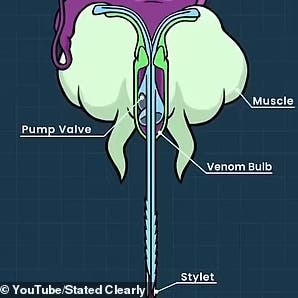Bee Stings: Watch Terrifying video closely what happens when a bee stings you
Who among us has not been exposed to a bee stings, or a wasp sting, all of which are painful, but a bee sting is a different story in terms of its intense pain, and those who have gone through this unfortunate experience know the truth about that.
But what is the reason behind this intense pain?
A clip shared on Twitter showed how bee stinging works, as it is a much more complex process than we expect, according to a report by the British Daily Mail.
When a bee stings, it releases a chemical called melittin into the victim’s body. This venom immediately activates pain receptors, causing a burning sensation.
Because the stinger of the bee is barbed like a serrated sword, the bee tears its abdomen when it flies, leaving the stinger in place and it dies soon after.
The longer the needle remains in the skin, the more venom is released, as its toxic attack may last for up to a minute.
Poison infusion
The clip also showed what the insect looks like up close, with the liquid pumped into the victim’s body, as the needle blades move back and forth and pump the poison and its flow increases deeper into the wound until the poison sac is completely emptied.
While bee stings are a risk, especially during the summer, home treatment is usually all that is necessary to relieve the pain.
Depending on who was stung and where, bee stings can produce different reactions, ranging from temporary pain and discomfort to a severe allergic reaction.
Just because there is only one type of reaction does not mean that you will always have the same reaction every time you are stung or that the next reaction will necessarily be more severe.
Symptoms and treatment
As long as you are not allergic to bee venom, your immune system will react to the sting by sending fluids there to flush out the melittin.
The pain can be relieved by applying a cold compress or applying an antihistamine.

Most of the time, bee sting symptoms are minor and include immediate, sharp burning pain at the sting site, a red spot, and slight swelling around the sting area.
In most cases, the swelling and pain go away within a few hours.



